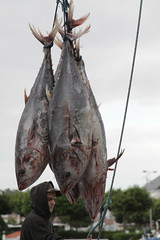Today the public faces "choices that will shape the fate of not just Atlantic bluefin tuna, not just all tunas, but all the great sea creatures — sharks, swordfish, marlin, even whales. For every one of these animals is highly migratory and roams the high seas, the vast, ownerless seascape that makes up some 60 percent of the oceans."
Thus an article in the NY Times called "Tuna's End," informs us.
What solution do you prefer in regards saving species in the sea?
Monday, June 28, 2010
Blood diamonds; blood phones
“Blood diamonds” have faded away, but we may now be carrying “blood phones.” Thus writes Nicholas D Kristof of the NY Times.
An ugly paradox of the 21st century is that some of our elegant symbols of modernity — smartphones, laptops and digital cameras — are built from minerals that seem to be fueling mass slaughter and rape in Congo.
See more.
An ugly paradox of the 21st century is that some of our elegant symbols of modernity — smartphones, laptops and digital cameras — are built from minerals that seem to be fueling mass slaughter and rape in Congo.
See more.
Saturday, June 19, 2010
NY Times: Recipe for Green Tires: Plants, Not Petroleum

125 discarded tires, Shreveport Clean Up: Montessori / Anderson Island / Stoner Hill
Originally uploaded by trudeau
By STEVEN ASHLEY
WITH each new model introduction, automakers take pains to point out how much they have done to reduce their vehicles’ negative effects on the environment. A rundown of the advances can involve almost every aspect of the car’s design and production: carbon dioxide output has been cut; paint application has changed to a water-based process; recycling and waste reduction at the factory has been improved to a point where nothing goes to a landfill.
more at
http://www.nytimes.com/2010/06/20/automobiles/20TIRE.html?ref=automobiles
Tuesday, June 01, 2010
Theories of Human development and the importance of Trade
From the Wall St Journal: Humans: Why They Triumphed
How did one ape 45,000 years ago happen to turn into a planet dominator? The answer lies in an epochal collision of creativity. By Matt Ridley
How did one ape 45,000 years ago happen to turn into a planet dominator? The answer lies in an epochal collision of creativity. By Matt Ridley
Subscribe to:
Posts (Atom)



